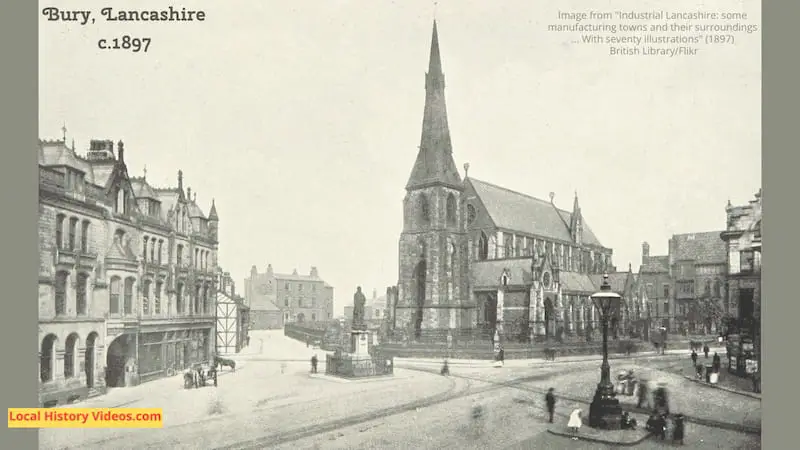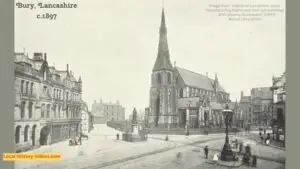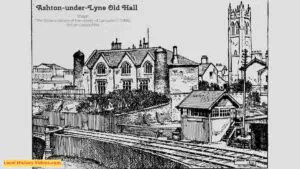Glimpse history through old images of Bury, Greater Manchester.
Bury was historically in the county of Lancaster but is now in Greater Manchester, in North West England, UK.
Bury Jubilee Week 1926
On Sunday, 5th September, 1926, local residents enjoyed the Mayorial Procession, part of the Bury Civic Jubilee celebrations.
Bury Jubilee Week & Cuts (1926) – British Pathé on YouTube
Jericho 1939
Once a separate village and now a district of Bury, Jericho’s name is thought to have arisen after the reverend John Wesley preached there in 1778.
The Redvales workhouse for 50 inmates was built in 1775, and was Bury’s first workshouse. Its name was changed to the Jericho Institution in 1929 and Fairfield Hospital in 1948.
Jericho (1939) – British Pathé on YouTube
Queen’s Lancashire Tour 1954
In 1954, Queen Elizabeth II made a two day tour of Lancashire. One of the tour stops was to open the new Town Hall at Bury.
Lancashire Only – Queen Continues Lancashire Tour (1954) – British Pathé on YouTube
Bury Changes in 1965
Bury experienced substantial redevelopment in the mid 1960s. A short piece of amateur film purchased on ebay gives a fascinating insight into the Greater Manchester town at a time of great change.
Because it was made by an enthusiastic amateur, the quality of the sound and images on this footage sometimes falters. The contents, however, allow modern audiences to see how familiar Bury streets were in a process of change more than half a century ago.
CHANGING PLACES – REGENERATION OF BURY (8mm, 1965)
When this film opens in 1965, the Bury regeneration programme is behind schedule because of financial constraints.
Permission had been granted to build the bypass road, which was to form the centre of the new planned environment.
We see the site of the now demolished Derby Hotel in the town centre’s Market Place. Already the replacement Ribblesdale House is nearing completion. In 2020, the building is home to a GP practice and domestic apartments.
The old fire station is still standing. Its replacement right next door is nearing completion in 1965, although the new control centre is already in operation.
Nearby the new premises for the Trustees Savings Bank (TSB) are open, following completion in September. Previously, they were located in Silver Street. Created in 1810, TSB ceased to exist in December 2005 when they merged with Lloyds Bank.
The narrator refers to a dispute over the new building’s modern design. A protest group worked to save a terrace of Georgian houses lower down the same road.
The Grammar Schools In Bury In 1965
Next, the film looks at the two Grammar Schools in the centre of Bury.
In 1965, the old Grammar School in Pemberton Street was recently reconditioned to become a girls school.
Over the road is the new Grammar School for boys, which cost £240,000 to build. It was officially opened on 27th September by notable educator Eric John Francis James, Baron James of Rusholme.
The new school boasted a language laboratory, extensive library, and large assembly hall. A small weather station sat in the school grounds.
Bury’s Vacant Shops In 1965
Back in the town centre, we see Lester House in Market Street. Unlike the busy business centre with occupied shops in 2020, back in 1965 the same building suffered a long line of unoccupied windows. The shop premises were advertised ‘at low rent’, with applications directed to Isaac Neild & Co in Mosley Street, Manchester.
Furthermore, in Bolton Street a group of shop premises have stood unoccupied throughout the summer, notes the narrator.
Walshaw Under Threat In 1965
The film now moves west of Bury town centre to the quiet village of Walshaw.
We see the village cross, period houses, and the church which dominates the landscape.
Earlier in 1965 the then-minister of Housing and Local Government Mr Richard Crossman put forward an order for the compulsory purchase of 164 acres to be used housing. There was also a further area identified for overspill development.
Objections to these plans came from the councils of Bury and Manchester, Lancashire county council, and several independent bodies. At the time of filming, Bury town council was seeking an appeal to the order.
Closing scene to this short film is the big tree on Dow Lane, looking across the lane and fields towards Walshaw. The tree has survived.
Bury Buses
These videos of local buses are trailers for DVD you can buy from PMP films. They naturally focus on the buses, but in the background you can see local homes, offices and businesses, passing cars, passengers (some of them waving), occasional pedestrians, and the occasional nuisance.
1995
BURY BUSES 1995 – DaveSpencer32 on YouTube
2000
BURY BUSES 2000 BY DAVE SPENCER OF PMP FILMS – DaveSpencer32 on YouTube
2002
BURY BUSES 2000 BY DAVE SPENCER OF PMP FILMS – DaveSpencer32 on YouTube
Historic Book
Extract from
“Industrial Lancashire: some manufacturing towns and their surroundings … With seventy illustrations”
by John Mortimer
Published in 1897
Pages 137-139
Bury must have been a place of small account in matters manufacturing in the twelfth century , and indeed appears to have remained so for four centuries succeeding , though the inevitable Flemings had established themselves here , fabricating their webs it is said “from the fleeces grown in the Forest of Tottington . ”
At the commencement of the sixteenth century Leland visited it and says , ” yerne sumtime made aboute Beri , a market towne on Irwel . ”
Two centuries later De Foe came this way , and the author of Robinson Crusoe says , ” we observed the manufacture of cotton , which is so great at Manchester , Bolton , etc. , was ended , and the woollen manufacture of coarse sorts , called half – thicks or kersies , begin,
which employs this and all the villages about it . ” Of these productions he says further : “The market for them is very great , though the town is situate so remote , so out of the way , and at the very foot of the mountains , that it would otherwise be but little frequented. ”
Mountain scenery in those days had little that was attractive to the traveller , and in addition to its wild background of elevated moorland there was a vast amount of unreclaimed bog – land about Bury , which has gradually got itself subdued to the useful and the good .
From a point near Castle Croft and not many yards in the rear of the old market place , and where , in front of the parish church three lines of tramways converge , the steam – trams running in and out there reminding you of a railway station , you can look upon the site of a good deal of this marshland and see the hills rising behind it .
Edwin Waugh , writing more than forty years ago and describing this view , says : “Immediately below the eminence upon which the castle stood , a low tract of ground of considerable extent , stretches away from below the semicircular ridge upon which the northern extremity of the town is situated , up the valley of the Irwell . Less than fifty years ago this tract was a great stagnant swamp , where , in certain states of the weather , the people of the neighbourhood could see the weird antics of the Wild Fire , ” or ” Jack o ‘ Lanterns , ‘ that fiend of morass and fen . ” Of this poisonous swamp he says , further , ” the valley so long fruitful of pestilence is now drained and cleared , and blooms with little garden allotments belonging to the working people thereabouts . “
To return , however , to our manufactures , it may be said that the weavers of Bury had made such progress in producing their woollen fabrics , that in Elizabeth’s time it was found necessary to appoint an aulneger , the duty of that scrutinising official being , as we know , to prevent the cloth being unduly stretched upon the tenter – hooks , to the prejudice of the buyer .
It was to the hand – worked woollen loom that , in 1738 , John Kay , of Bury , applied his wonderful picking – stick or peg , by which , held in the weaver’s hand , and communicating by means of cords with pickers or drivers in the shuttle – boxes , the shuttle was jerked from side to side through the open warp shed . This shuttle throwing had previously to be done by hand , and in wide looms two weavers had been necessary ; now the weaver’s power of producing cloth was quadrupled , and a new era had dawned .
Kay tried his invention first at Colchester , but the weavers would have none of it , then he came north again , but here in his own county , though his fly – shuttle appears to have been better received , in other respects the inventor fared ill.
To quote from what has been recorded elsewhere , “at Bury he carried on business as an engineer, and also occupied himself with making improvements in his spinning machinery, but the fact becoming known , was the cause of several disturbances on the part of the
spinners . At length in 1753 a mob broke into Kay’s house , destroying everything they found , and would no doubt have killed him had he not been conveyed to a place of safety in a wool sheet. ”
Ultimately he died in France in poverty and obscurity .
The inventive genius of the father in this case was transmitted to his son Robert , who , in 1760 , produced a drop box , whereby a weaver at a handloom could , at his pleasure , use several shuttles of different coloured weft yarns and so produce a variegated cloth . These inventions marked the limit of development in the handloom with which , in this regard , Bury is intimately associated.
More about Greater Manchester
- Old Images of Greater Manchester, England
- Old Images of Tyldesley, England
- Old Images of Heywood (Lancashire, now Greater Manchester)
- Old Images of Chadderton, England
- Old Images of Ashton-in-Makerfield, England
- Old Images of Ashton-under-Lyne, UK
.
Back to Greater Manchester page
Back to Local History Videos home page




